Research conducted by Answers in Genesis staff scientists or sponsored by Answers in Genesis is funded solely by supporters’ donations.
Abstract
Biosystematics is in great flux today because of the plethora of genetic research continually shedding light on organism relationships. Despite the large amount of data being published, the challenge is having enough knowledge about genetics to draw conclusions regarding the biological history of organisms and their logical taxonomic placement. Despite these uncertainties, an initial attempt to count and identify Anuran kinds was completed using current information and several key assumptions and guidelines. These include focusing on monophyly, maintaining stability as it pertains to the association of names and their taxa, relying on authors who demonstrate expertise in systematics, hybridization as evidence that species belong to the same kind, the relevance of the cognitum, and assessing characters in order to determine holistic continuity and discontinuity using statistical baraminology. Taking the above into consideration and realizing that Anuran taxonomy is in great flux with new species being identified every year, it is estimated that 140 extant Anuran kinds were brought on the Ark.
Keywords: Ark Encounter, biosystematics, taxonomy, lissamphibian, Anuran, frogs, toads, kind, baraminology
Introduction
Creation research should be guided by God’s Word which is foundational to the scientific models that are built. The Ark Encounter Project has tasked creation researchers to investigate several questions, some of which include
- What did God mean by kind when He told Noah to bring two of each and seven—sevens of clean animals on board (Turner 2009; Williams 1997)?
- How have organisms diversified from their Ark ancestors (Wood 2003)?
- How can the Ark kind be recognized from today’s organisms (Brophy and Kramer 2007; Lightner et al. 2011; Sanders and Wise 2003)?
- How many kinds were taken on board the Ark (Woodmorappe 1996)?
In a previous paper the number of caudate and caecilian kinds were estimated (Hennigan 2013). The purpose of this paper is to make an initial estimate of the identification and number of Anuran kinds taken on board the Ark using all available information.
The State of Biosystematics and Taxonomy
Today Biosystematics is the science of discovering, classifying, and organizing creatures based on the analysis of diversity. The science of identifying taxa and naming organisms is taxonomy. There is no universally accepted procedure for organism classification (Amphibiaweb 2013). Currently, these disciplines are in great flux as researchers are putting more emphasis on new genetic data for phylogeny development; much is being changed accordingly.
Therefore, how organisms are named and organized today has changed, and may change more tomorrow. Major sources for amphibian classification include; Blackburn and Wake 2011; Dubois 2005; Duellman and Trueb 1986; Duellman 1999; Frost 1985; Frost et al. 2006; Pyron and Wiens 2011. Herpetologists at Amphibiaweb (2013), using these sources, have outlined the following criteria for their taxonomic recommendations:
- Of primary importance focus on monophyly and identify the clade consisting of species and their descendants based on morphological and genetic characters.
- Maintain stability as it pertains to the association of names and their taxa.
- Rely on authors who demonstrate expertise in systematics.
- Consider the usefulness and general acceptance of nomenclature by amphibian researchers.
- Focus on “tree” thinking rather than nested hierarchies.
Creation biologists differ in their assumptions in that they focus on “forest” thinking and are interested in how creatures have diversified from the originally created baramins and more specifically, the archetypes that left the Ark. Though there are overlaps with the above criteria, Lightner et al. (2011) outline the following guidelines, in descending priority, from a baraminological perspective:
- Biblical evidence suggests that living things reproduce after their kinds and therefore the ability to hybridize in extant creatures will be evidence that they are the same kind (Genesis 1 and 7).
- Though it was not meant to be used to identify Ark kinds, is the cognitum concept relevant (Sanders and Wise 2003)?
- Assess characters in order to determine holistic continuity and discontinuity amongst and between organisms using statistical baraminology (Wood 2006a; Wood 2006b).
For the purposes of this paper, all of the above will be considered while incorporating the following precautions and perspectives. Baraminologists tend to equate kinds with the family, and for many cases with good reason (Wood 2006a). However, we should carefully analyze the structures, behaviors, and physiologies of members of a putative kind and look at the genetic reasons why a certain member of a kind doesn’t have characters that the other members possess. Scripture, especially for herptiles, does not shed much light about their kinds. The challenge is to demonstrate where discontinuities lie, and there is not enough information to do that. Wilson (2010) argues that there is a need to compare whole genomes of frog species and genera in order to see if there is genomic equivalence. Did any members of a kind have features not present in other members of the same kind and if so, why? Hybridization data is also limited and has not been tested in most. Biogeographic data may shed light on any geographic patterns based on Ark dispersal however, until we can demonstrate either empirically or theoretically that fairly disparate species can arise from a founder population of two, we have to be careful about lumping smaller taxa into large ones and calling the larger taxon an Ark kind. Therefore, this research is meant to be a foundation upon which further research and understanding of God’s diverse organisms can be built. Within his Trinitarian character God is diverse and we would expect that his creation would reflect that diversity in his creatures (e.g. genetics, species, populations, communities, and ecosystems). When we better understand what mechanisms are involved in the production of differences, we should be better able to infer whether they are traits produced by direct creation, post-Flood diversification through unknown genetic preprogrammed mechanisms, and/or random mutations.
For example, recent research has shown that exposure to a few small molecules will change the gut morphology of anuran tadpoles. The African clawed frog (Xenopus laevis) larvae could be induced to change from herbivorous to carnivorous via manipulation with these molecules. It was also demonstrated that Budgett’s frog larvae (Lepidobatrachus laevis) could be changed from carnivorous to herbivorous by reverse manipulation (Bloom et al. 2013). These molecules act to modulate a morphogenetic pathway common to both species. These findings have interesting implications for rapid diversification of vertebrate phenotypes in short amounts of time. Further study will likely affect our understanding of how species should be grouped according to their kinds.
In the case of Anurans, there is considerable variation within families and there will be an attempt to balance between lumping and splitting taxa. There will be times when I identify the kind at the family or above and other times where I will defer to the genus because the reasons for variation or abilities to survive Flood waters are unknown.
Order Anura
As previously reported Superclass Tetrapoda contains Class Amphibia which are four-legged vertebrates lacking an amniotic membrane and include frogs, salamanders, and caecilians (Hennigan 2013). Subclass Lissamphibia includes all extant amphibians. Taxon Salientia includes all living and extinct frogs, while taxon Anura is considered a phylogenetic crown group containing ancestors of all living frog taxa and their descendants (Vitt and Caldwell 2009, p. 89).
The word anuran comes from two Greek words that mean without (an) tail (oura) and refers to the tailless frogs and toads (Bergman 2013; Pough 2004). Toads and frogs are the same creature but may have a few differences (Jensen et al. 2008, p. 32). For example, some toads can be distinguished from some frogs because they have short legs used for hopping, rather than leaping, and have a semi-dry and warty skin which is an important design feature for living in arid conditions. Some frogs are powerful leapers and can jump two to 40 times their body length (Vitt and Caldwell 2009, p. 435). There are exceptions to these differences and they will be noted under each family description later.
Anurans represent 88% of all Lissamphibians and their taxonomy is in constant flux and controversy. Currently Anura contains 54 families, 430 genera, and 6296 species (Amphibiaweb 2013). Since the goal of naturalistic taxonomy is to reveal evolutionary relationships, anuran groupings are based on evolutionary presuppositions. Depending on the source, anurans used to be divided into three clades; extinct frogs (Proanurans), extant Mesobatrachia (“middle” frogs), and extant Neobatrachia (“new” frogs). The fossil record tends to have these groups in an evolutionarily predicted chronological sequence, but current naturalistic interpretations of phylogenetic analysis is showing modern frogs to be much more complex and hierarchical than the fossil data suggests (Vitt and Caldwell 2009, p. 89). Some researchers refer to extant suborders as Archaeobatrachia (“primitive” frogs), Mesobatrachia (“middle” frogs), and Neobatrachia (“new” frogs) (Roelants and Bossuyt 2005).
Unique traits that frogs share include shortened vertebral columns, nine or less vertebrae, reduced or absent unicapitate dorsal ribs, firmly articulated presacral vertebrae, postsacral vertebrae uniquely fused into a urostyle bone that lies between two illial bones, fused forelimbs and hindlimbs called the radioulna and tibiofibula respectively, and elongate ankle bones called the astragalus and calcaneum that provide solid support (Vitt and Caldwell 2009, p. 436).
Some have argued that frogs were not on the Ark because a high percentage of their respiratory gas exchange occurs through the skin. Though true, they also fit the biblical description of creeping things that breath air and have nostrils (Genesis 7:14, 22). Anurans have a positive pressure buccal pump type of respiration that is both continuous and separate from lung ventilation (Vitt and Caldwell 2009, pp. 186–187). When the floor of the mouth drops, the nares (nostrils) take oxygen into the buccal (inner mouth) cavity and store it temporarily while deoxygenated air from the lungs is rapidly exhaled out the nares with minimal mixing. Then, nares close and the floor of the mouth rises and forces the new air from the buccal cavity into the lungs. This process explains why the throats of frogs are going in and out constantly.
A trait unique to several anurans involves their life cycle. Many undergo indirect development where the larval or tadpole stage is so dramatically different from the adult, physiologically, ecologically, and behaviorally, that the changes that must occur during metamorphosis are vast (Vitt and Caldwell 2009, p. 435). Some researchers hypothesize that paedomorphy, which has been documented in some caudates (Hennigan 2013), has not been documented in anurans because of this complex and unique metamorphosis (Vitt and Caldwell 2009, p. 435). A classification system of tadpole morphology (Orton Types I-IV) based on evolutionary assumptions, mouth and opercular (gill cover) structure, and spiracle (tube-like respiratory opening) number and position was devised in the 1950s and at times I will refer to this classification system when comparing and contrasting anuran taxa (Orton 1953; Orton 1957; Roelants, Haas, and Bossuyt 2011). Orton Type I tadpoles have two spiracles with no teeth or beak. Orton Type II tadpoles also lack teeth and a beak but have one spiracle located on the venter. Orton Type III tadpoles have small teeth and a beak with a spiracle on the venter. Orton Type IV tadpoles have many teeth with a pronounced beak and a spiracle located on the left side.
What follows are brief descriptions of the currently identified families, which will further illuminate their unique traits and distinctions. Average snout to vent lengths (SVL) have been ascertained from data reported in Vitt and Caldwell (2009) and Amphibiaweb (2013).
Suborder Archaeobatrachia
1. Midwife Toad kind
Family Alytidae or Discoglossidae
3 genera (Alytes/Discoglossus/Litonia),
12 species—SVL = 6 cm (2.3”)

Source: http://en.wikipedia.org/wiki.
Fig. 1. Alytes obstetricans.
Alytidae and Discoglossidae used to be separate families, but taxonomists have combined them into Alytidae. Found in Western Europe, North Africa, and Israel, whereas most frogs have long tongues, members of this family have rounded or disc-shaped tongues. These mostly terrestrial to somewhat aquatic frogs have indirect development with Orton Type III tadpoles. Common traits include no palatine bones of the maxilla, a pair of frontoparietal bones on the skull, eight presacral, opisthocoelous (front end of the centrum, or vertebrae body, is flat or convex and the back is concave), post metamorphs with ribs on the second to fourth presacral vertebrae, blunt to pointed tips on the terminal phalanges, astragalus and calcaneum (tarsal bones) are fused at their proximal and distal ends, arciferal pectoral girdle (a frog morphology where the cartilage [epicoracoid] at the end of the paired bones that make up the shoulder assembly [coracoid] are fused in the front but are separate and overlap in the back. The more prevalent anuran pectoral girdle morphology is the fermisternal form where the epicoracoid cartilage is fused in both back and front), a distinct sternum, and the facial nerve exiting through the facial foramen in front of the auditory capsule (Vitt and Caldwell 2009, pp. 440–441).
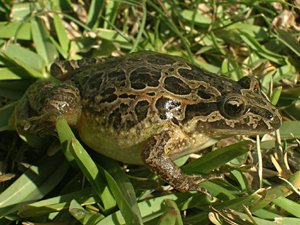
Source: http://en.wikipedia.org/wiki.
Fig. 2. Discoglossus galganoi.
There is still much about their life histories that is not known. In both genera, males and females use their voices to communicate during mating season. Many frogs exhibit a mating behavior called amplexus where the male mounts a female and each discharges their corresponding sperm and eggs into the environment. External fertilization happens when sperm fertilize eggs outside of the body. Depending on the taxon, males grab females at different locations. When males clasp females under the armpits it is called axillary amplexus. If males grab females around the abdomen in front of the hind legs it is lumbar amplexus. A unique behavior observed in poison dart frogs is cephalic amplexus where the male grasps the female around the head. Inguinal amplexus happens when the male grasps the female lower than the lumbar region, around the waist. Generally, Alytidae amplexus is either lumbar or inguinal.
What follows is a description of what has been observed and recorded by Amphibiaweb (2013) for Alytes cisternasii reproductive behavior. Once lumbar amplexus takes place in the water, the male kicks his legs and she rocks back and forth. As time goes on, she releases eggs and he lets go of her in order to release sperm. He then winds the stringy and fertilized egg mass, of about 180 eggs, around his ankle. He takes care of them until they become Type III larvae ready to hatch, and then will release them into a body of water so they can complete their development. This behavior is why they are called midwife toads and it is quite unique among anurans. Alytes are also nocturnal, fossorial, and may inhabit forests, ponds, or streams (Vitt and Caldwell 2009, pp. 440–441).
Discoglossus is more aquatic, are most often found near fast flowing streams, and eggs tend to be deposited in the water and left on vegetation, rather than cared for by a parent (Vitt and Caldwell 2009, p. 441).
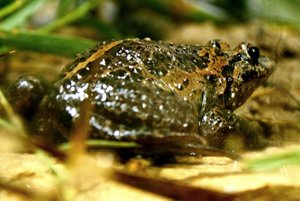
Source: http://en.wikipedia.org/wiki.
Fig. 3. Latonia nigriventer.
Litonia is a genus that has long thought to be extinct until the recent 2011 rediscovery of the Hula painted frog (Latonia nigriventer) from northern Galilee (Biton et al. 2013). It was the first amphibian to be declared extinct by the International Union for the Conservation of Nature (IUCN), hasn’t been seen in 60 years, and is considered a living fossil (Amphibiaweb 2013). No hybridization data was identified.
Family Bombinatoridae
2 genera (Barbourula/Bombina)
10 species
Both genera are mostly aquatic toads. Traits shared include a fused sphenethmoid (bone surrounding anterior part of brain in amphibians), absent epipubic muscles, vertical or triangle-shaped pupils, expanded flange in the quadratojugal (a small jaw bone), bone tissue formed in the hyoid plate, no palatine bones of the maxilla, paired frontoparietal bones, eight presacral opisthocoelous vertebrae, post metamorphs having ribs on the second to fourth presacral vertebrae, blunt to pointed tips on terminal phalanges, astragalus and calcaneum fused at their proximal and distal ends, arciferal pectoral girdle, distinct sternum, and facial nerve exiting through the facial foramen in front of the auditory capsule (Amphibiaweb 2013; Vitt and Caldwell 2009, p. 441).
Bombina consists of eight species and can be found in Eurasia. This genus has a Type III larvae, webbed toes, but not webbed fingers, and fossil data (Amphibiaweb 2013; Cannatella 2008b). As a diurnal species, Bombina has bright aposematic coloration on their venters which is inferred to be a defense against potential predators because bright colors may advertise their skin toxicity. When threatened, some stiffen into a position called the “unken reflex” where their coloring (and skin toxins) are most exposed to the predator (Amphibiaweb 2013). Some caudates such as the toxic eastern spotted newt (Notophthalmus viridescens) are known for this behavior too. Bombina species also inhale when they vocalize, which is not known in any other anuran species. Aquatic environments they inhabit include swamps, rice fields, water channels, ponds, and polluted waters. Interspecific hybridization has been reported for Bombina (Yanchukov et al. 2006).
In contrast, Barbourula is located in the Philippines and Borneo, has webbed toes and fingers, and its larval development strategies are unknown (Amphibiaweb 2013; Cannatella 2008a). There is speculation that Barbourula larvae may undergo direct development, as evidenced by adults found with large eggs, but its developmental natural history continues to be a mystery. The genus consists of two species that don’t have the bright colors found in Bombina, are nocturnal, and mainly found in fresh water streams. There is no interspecific hybridization or fossil data reported for this genus (Amphibiaweb 2013).
Because of the controversial taxonomy, the little known or unknown life histories, and a desire not to underestimate the Ark kinds, I will default to the genus until more data are collected.
2. Fire-Bellied Toad Kind
Genus (Bombina)
8 species—SVL = 5 cm (1.9”)
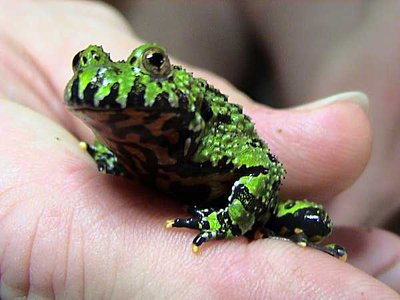
Source: http://en.wikipedia.org/wiki.
Fig 4. Bombina orientalis.

Source: http://www.petcaregt.com/blog/frog-list.html.
Fig 5. Bombina bombina.
3. Jungle Toad Kind
Genus Barbourula
2 species—SVL = 6 cm (2.3”)

Fig. 6. Philippine flat-headed frog (Barbourula busuangensis). © Chien Lee / MINDEN PICTURES
4. Tailed Frog Kind—Ascaphidae
1 genus (Ascaphus)
2 species—SVL = 4 cm (1.5”)
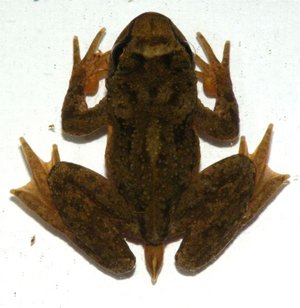
Source: http://en.wikipedia.org/wiki.
Fig. 7. Ascaphus truei.
Found in fast flowing streams from western Canada to California and into the Rocky Mountains, this family is unique in that members contain an everted cloaca (“tail”) used as a copulatory organ for internal fertilization (Amphibiaweb 2013). This organ is powered by caudalipuboischiotibialis muscles, found only in Ascaphidae and Leiopelmatidae. These are the same muscles that control the wagging of a dog’s tail (Amphibiaweb 2013; Cannatella 2008b). Other traits include; no palatine bones, paired frontoparietal bones, nine presacral, amphicoelous vertebrae (front and back of centrum are concave), free dorsal ribs on the second to fourth (sometimes the fifth) presacral vertebrae on adults, blunt to pointed tips of the terminal phalanges, astragalus and calcaneum fused at their proximal and distal ends, arciferal pectoral girdle, distinct sternum, vertical pupils, and facial nerve exiting through the facial foramen in front of the auditory capsule (Amphibiaweb 2013; Vitt and Caldwell 2009, p. 437). During the breeding season males do not vocalize, copulation takes place underwater, and the Type III larvae may metamorphose in four to seven years (Amphibiaweb 2013). Though mostly aquatic, there is no reason that Noah could not have had these on board. Because of respiratory anatomy, doubts about Flood survival hardiness, and to avoid underestimating Ark kind numbers, I include them until further data shows obvious post-Flood diversification from other terrestrial anuran taxa.
5. New Zealand Frog kind—Leiopelmatidae
1 genus (Leiopelma)
4 species—SVL = 5 cm (1.9”)

Photo: G. Shirley. Source: http://www.forestandbird.org.nz
Fig. 8. Hochstetter’s frog.
Only found in New Zealand, these frogs and Ascaphidae are considered primitive because the two families share traits that include nine presacral amphicoelous vertebrae and the retention of caudalip uboischiotibialis muscles (Amphibiaweb 2013).
Leiopelmatidae shared characters include round pupils, no protrusible tongues (unlike most anurans), ventral inscriptional ribs found in no other extant anuran (elongate cartilage embedded in the abdominal wall), direct development, no mating vocalizations, inguinal amplexus, alternate kicking when swimming (unlike most anurans), nocturnality, gray-brown color, reduced lungs, one condyle on the urostyle, arciferal pectoral girdle, facial nerve exiting the facial foramen in front of the auditory capsule, no palatine bones of the maxilla, paired frontoparietal bones, blunt to pointed terminal phalanges, and the astragalus and calcaneum are fused at both ends (Amphibiaweb 2013; Vitt and Caldwell 2009, p. 437).
Some have wanted to combine the above families into one, but differences in molecular characters are interpreted as showing that the two families are highly divergent (Cannatella 2008c). Though extant species are small frogs (e.g. 4–5 cm [1.5”– 2”]), fossil Leiopelma reached 10 cm (3.9”) in length (Amphibiaweb 2013; Cannatella 2008c). These frogs are terrestrial and do not lay eggs in standing water. Instead they find damp microhabitats under rocks and logs to deposit eggs. Direct parent care occurs with L. hamiltoni and L. archeyi where the adult male protects the eggs by sitting on them. When the young hatch, they will climb on to the male’s back and complete their development there (Cannatella 2008c). L. hochstetteri is different because after hatching, the larvae are moved to nearby water bodies and will complete their development without parental care (Cannatella 2008c). No hybridization data was found. Since they are unique in many ways, and so that the Ark numbers are not underestimated, I place the family as a created kind.
Suborder Mesobatrachia
6. Spadefoot Toad Kind
Families Pelobatidae and Scaphiopodidae
3 genera (Pelobates/Scapheopus/Spea)
11 species—SVL = 7 cm (2.7”)

Source: http://en.wikipedia.org/wiki.
Fig. 9. Spea hammondii.
These families were classified as one family, Pelobatidae, but have recently been separated. Because of very similar morphology and behavior, I am tentatively keeping them as one kind. Common traits include warty and soft skin, fused sacrum and urostyle joint, keratinized “spade” on each hind foot that is used for digging, eight presacral amphicoelous vertebrae, arciferal pectoral girdle, distinct sternum, absent palatines, vertical pupils, facial nerve exiting in front of acoustic foramen in the auditory capsule, no dorsal ribs on presacral vertebrae of post metamorphs, astragalus and calcaneum are fused at both ends, blunt tips on terminal phalanges, and short legs (Vitt and Caldwell 2009, pp. 441–445). Many have bony outgrowths on the frontal and parietal bones of the skull (Amphibiaweb 2013; Vitt and Caldwell 2009, pp. 441–445).

Photo: Daniel Phillips. Source: http://www.herpfrance.com.
Fig. 10. Pelobates fuscus.
Pelobatidae species are found in Eurasia and North Africa and Scaphiopodidae species range from southern Canada to southern Mexico (Amphibiaweb 2013). Mostly fossorial, they are designed to thrive in arid habitats, but depending on the species, can be found in a variety of ecosystems. They are explosive breeders in which intense mating takes place in short amounts of time. They emerge from the ground after heavy rains to fertilize their eggs in temporary pools (Amphibiaweb 2013; Cannatella 2008d). Tadpole development is the fastest known in anurans and many are capable of phenotypic plasticity; that is, depending on the species and resources available, their phenotypes can be in several forms. Omnivorous morphs have flat beaks, round bodies, and small jaw muscles. The flat-headed carnivorous tadpoles, many of which are cannibalistic, have enlarged jaw muscles and pronged beaks (Amphibiaweb 2013). Interspecific hybridization in Spea has been reported both in the wild and in captivity (Amphibiaweb 2013).
7. Parsley Frog kind—Pelodytidae
1 genus (Pelodytes)
3 species—SVL = 5 cm (1.9”)

Source: http://www.popularpets.net/
Fig. 11. Pelodytes punctatus.
From Eurasia, their name comes from some members having what looks like parsley garnish on the skin. Shared characters include fused astragalus and calcaneum (found also in glass frogs, family Centrolenidae), parahoid bone (also found in burrowing toads, family Rhynophrynidae and extinct frogs from genus Palaeobatrachus), fused vertebrae I and II, three tarsalia bones on each foot, eight presacral amphicoelous vertebrae, arciferal pectoral girdle, distinct sternum, no palatines, vertical pupils, facial nerve exiting in front of acoustic foramen in the auditory capsule, post metamorphs lacking dorsal ribs on presacral vertebrae, blunt to pointed tips of terminal phalanges, and short legs (Amphibiaweb 2013; Heying 2003; Vitt and Caldwell 2009, p. 443). Their breeding behavior is not explosive, but prolonged, where mating intensity is lower than explosive breeders and happens over a long period of time, usually consisting of two or more months. Development is indirect and tadpoles may take a year or less, depending on species, to metamorphose (Amphibiaweb 2013). Molecular data places them as a sister to the clades of Pelobatidae and Megophryidae (Amphibiaweb 2013).

Source: http://en.wikipedia.org/wiki/.
Fig. 12. Pelodytes ibericus.
8. Burrowing Toad Kind—Rhinophrynidae
1 genus (Rhinophrynus)
1 species—SVL = 8 cm (3.1”)
The Mexican burrowing toad is a fossorial creature and is the only one of its kind. Its range extends from south Texas through South America to Costa Rica. Traits include short, strong legs, pointed snout, pectoral girdle that overlaps head, bulbous body, small eyes, anteater-like tongue that comes through a narrow opening of the mouth uniquely designed to feed underground on ants and termites, no teeth, no palatines, facial nerve exiting through the anterior acoustic foramen in the auditory capsule, eight presacral notochordal and opisthocoelous vertebrae, post metamorphs lacking dorsal ribs on presacral vertebrae, arciferal pectoral girdle, no sternum, calcaneum and astragalus fused at both ends, blunt tips on terminal phalanges, and a Type I tadpole—also found in the tongueless frogs of family Pipidae (Amphibiaweb 2013). They are explosive breeders and mate when heavy rains form large pools. Because of their uniqueness I include them as a separate Ark kind.

Source: http://en.wikipedia.org/wiki/.
Fig. 13. Rhinophrynus dorsalis.
Family Pipidae
4 genera
Hymenochirus/Pipa/Xenopus/Pseudhymenochirus
33 species
Common traits in this family include aquatic lifestyle, no tongues, flat bodies, webbed hind feet, lateral line system retained in adults (used to locate prey and sense surroundings by detecting pressure differences in water), Orton Type I tadpoles, generally no vocal cords in males (with a possible exception of Hymenochirus boettgeri) but are able to use a clicking sound underwater to communicate with females, unusual aquatic amplexus behavior where frog pairs somersault (perform “turnovers”) underwater, no quadratojugal (cheekbone), free ribs in larvae, sacrococcygeal articulation fused, short, stocky sacrum, elongate septomaxillae, no palatines, one frontoparietal bone, facial nerve exiting the anterior acoustic foramen in the auditory capsule, six to eight presacral opisthocoelous vertebrae, post metamorphs having dorsal ribs fused to second through fourth vertebrae, calcaneum and astragalus are fused at both ends, and pointed terminal phalanges (Amphibiaweb 2013; Vitt and Caldwell 2009, pp. 439–440). Despite their aquatic nature, they are easily kept in captivity as pets and for genetic studies. I have broken this family into three kinds for reasons described below.
9. Dwarf Clawed Frog kind
Genera—Hymenochirus and Pseudhymenochirus
5 species—SVL = 3 cm (1.1”)

Source: http://en.wikipedia.org/wiki/.
Fig. 14. Hymenochirus boettgeri.
These differ from African clawed frogs in that they are smaller, have four webbed feet, eyes on the sides of their head, and snouts that are flat and curved. All adults and tadpoles may be predatory suction feeders and H. boettgeri males sing (Amphibiaweb 2013). Because little is known about the African genera Hymenochirus and Pseudhymenochirus, the ease in which they are kept in captivity, the respiratory anatomy, and to avoid underestimating kinds, I include them in the Ark as the dwarf clawed frog kind.
10. African Clawed Frog kind
Genus Xenopus
21 species—SVL = 6.5 cm (2.5”)

Source: http://en.wikipedia.org/wiki/.
Fig. 15. Xenopus laevis.
African clawed frogs are twice the size of dwarf clawed frogs, have eyes on the tops of their heads, and have pointed snouts. Polyploidy characterizes Xenopus and interspecific hybridization has been documented. It is thought that hybridization produced all 21 species (Vitt and Caldwell 2009, p. 439).
Because of their unique genetics, they have been important scientific model organisms in disciplines such as neurobiology, toxicology and developmental biology. Xenopus tadpoles resemble catfish because of paired barbells on the front of the mouth and have an epipubis (cartilage or bone in front of pubis). Because of hybridization data, the ease in which they are kept in captivity, the respiratory anatomy, and to avoid underestimating kinds, I include them in the Ark.
11. Surinam Toad kind
Genus Pipa
7 species—SVL = 12 cm (4.7”)
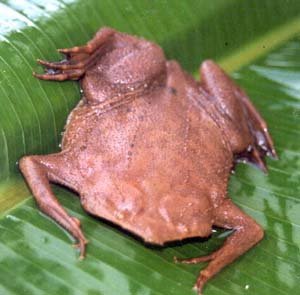
Source: http://en.wikipedia.org/wiki/.
Fig. 16. Pipa pipa.
A South American anuran, Pipa reproduction is highly unusual as inguinal amplexus and turnover behavior may last hours. As the female rolls on her back and releases eggs, the male will fertilize them and push them into her dorsal skin. The 12 hour amplexus may provide the time and stimulation needed for the back of the female skin to morphologically change so that fertilized eggs can embed and develop there. This is called dermal brooding (Vitt and Caldwell 2009, p. 440). In three species (P. arrobali, P. aspera, and P. pipa) development is direct and toadlets hatch from skin pockets (Amphibiaweb 2013). For P. carvalhoi, P. myersi, and P. parva development is indirect and Orton Type I tadpoles emerge from the skin and finish their metamorphosis in the environment (Amphibiaweb 2013; Vitt and Caldwell 2009, p. 440). The developmental process in P. snethlageae is unknown and no hybridization data was found. Because of their unique dermal brooding, respiratory anatomy, my desire to avoid underestimating Ark kinds, and relative ease of keeping in captivity, I include them in the Ark as a kind.
12. Tukeit Hill Frog kind—Allophrynidae
1 genus (Allophryne)
2 species—SVL = 3 cm (1.1”)

Source: http://www.nhptv.org/wild.
Fig. 17. Allophryne ruthveni.
This is a terrestrial, semi-arboreal South American frog that lives on low shrubs from 1–3m (3.2’–9.8’) tall. It is an explosive breeder and has been very difficult to classify. They have recently been separated into their own family (Amphibiaweb 2013). They superficially look like a member of the tree frog family (Hylidae) and used to be classified there. However, tree frogs have claw shaped terminal phalanges where Allophrynidae have T-shaped terminal phalanges (as is found in other families such as Heliophrynidae). Molecular data places them as a sister taxon to Centrolenidae or the glass frogs which seems consistent with the observations that sometimes their ventral side is transparent so that internal organs are seen, while weak molecular data places them in Centrolenidae (Amphibiaweb 2013). Other traits uniting this controversial family include eight presacral vertebrae, no ribs, a free urostyle, an arciferal pectoral girdle, clavicles that don’t overlie the scapula, no teeth, sartorious muscle separate and distinct, horizontal pupils, palatines present, astragalus and calcaneum completely fused, Orton Type IV aquatic larvae, and no fossil data (Amphibiaweb 2013; Cannatella 2008a). No hybridization data was found either. Since there is so little data regarding their life history and the taxonomic status is controversial, I shall keep them as a separate kind until further research illuminates their taxonomic status.
Family Megophryidae
11 genera
174 species—SVL = 6 cm (2.3”)
Because so little is known about many genera, the average snout-to-vent length was taken for what is known about the family because they range in size from 1.5–12 cm (0.5–4.7”) (Vitt and Caldwell 2009, p. 443). Habitat preference is under forest leaf litter and they are cryptic, blending well into their environment by mimicking dead leaves on the forest floor. Some species have epidermal extensions that make them look like leaves with their corresponding venation (Amphibiaweb 2013; Vitt and Caldwell 2009, p. 443). Breeding occurs in the flowing waters of streams and rivers; tadpoles are different Orton types depending on genera. Five of the genera (Leptobrachella, Leptolalax, Megophrys, Ophryophryne, and Xenophrys) have fossorial tadpoles with unique bony vertebrae and corresponding musculature that enable them to burrow into the rocky substrates of streams (Vitt and Caldwell 2009, p. 443).
Ecologically and morphologically they are one of the most diverse anuran families and range from south to southeastern Asia (Amphibiaweb 2013). Shared traits include nocturnal behavior, poor jumping ability, paddle-shaped tongue, arciferal pectoral girdle with long bony sternum, no palatines, paired frontoparietals, facial nerve exiting through anterior acoustic foramen in the auditory capsule, eight presacral amphicoelous vertebrae, no ribs on post metamorphs, astragalus and calcaneum fused on ends, blunt or pointed tips on terminal phalanges, and inguinal amplexus (Amphibiaweb 2013; Vitt and Caldwell 2009, p. 443). No hybridization data was found.
Much is unknown about many of these genera, so I have tentatively split this family into several kinds in order to avoid underestimating numbers because of a lack of information. Average snout-to-vent-lengths are extremely approximate.
13. Horned Frog kind
– includes genera Borneophrys (1 species), Brachytarsophrys (5 species), Megophrys (6 species), Ophryophryne (5 species)—SVL = 8 cm (3.1”)
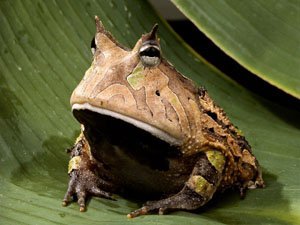
Source: http://www.nationalgeographic.com.
Fig. 18. Ceratophrys cornuta.
14. Borneo Frog kind—Leptobrachella
7 species—SVL = 3 cm (1.1”)

Source: http://www.frogsofborneo.org.
Fig. 19. Leptobrachella baluensis.
15. Litter Frog kind—Leptobrachium
33 species—SVL = 5 cm (1.9”)
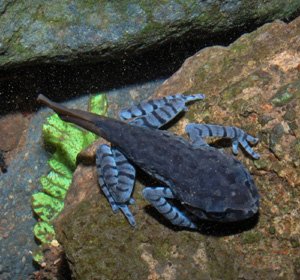
Source: http://en.wikipedia.org/wiki.
Fig. 20. Leptobrachium hasseltii.
16. Asian Toad kind—Leptolalax
35 species—SVL = 4 cm (1.5”)

Source: http://en.wikipedia.org/wiki.
Fig. 21. Leptolalax liui.
17. Toothed Toad kind—Oreolalax
17 species—SVL = 5.5 cm (2.1”)
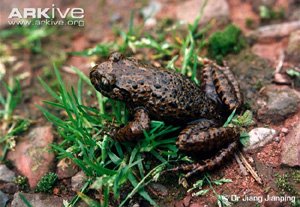
Photograph: Dr. Jiang Jianping. Source: http://www.arkive.org.
Fig. 22. Oreolalax omeimontis.
18. Cat-Eyed Toad kind—Scutiger
20 species—SVL = 5 cm (1.9”)

Photograph: Li Cheng. Source: http://www.arkive.org.
Fig. 23. Scutiger tuberculatus.
19. Vietnam Toad kind—Vibrissaphora
1 species—mostly unknown and no pictures.
Suborder Neobatrachia
Family Brachycephalidae
2 genera (Brachycephalus and Ischnocnema)
53 species—SVL = 3.5 cm (1.3”)
A taxon found in Brazil and northern Argentina, it is connected mostly by molecular characteristics (Amphibiaweb 2013). These frogs have two digits on the hands, three or four digits on the feet, perform inguinal or axillary amplexus, paired palatines, paired frontoparietals, a facial nerve exiting anterior acoustic foramen, seven presacral procoelous vertebrae (front end of the centrum is concave and the back is flat or convex), no dorsal ribs in post metamorphs, arciferal pectoral girdle with no sternum, and astragalus and calcaneum fused at both ends (Amphibiaweb 2013, Vitt and Caldwell 2009, p. 449). Because the information is limited to a few species in these genera and no hybridization data has been found, I have defaulted the kind to the level of the genus until more information is known.
20. Saddle-Back Toad kind—Brachycephalus
20 species—SVL = 1.5 cm (0.6”)

Photograph: J. P. Pombal, Jr. Source: http://www.arkive.org.
Fig. 24. Brachycephalus pernix.
They are quite small and are called saddle-back toads because they have bony shields above their vertebrae (Amphibiaweb 2013). Some, such as B. ephippium, have bright aposematic coloration because they produce tetrodotoxin, a strong toxin also found in some newts (Amphibiaweb 2013).
21. Robber Frog kind—Ischnocnema
33 species—SVL = 5 cm (1.9”)

Source: http://eol.org.
Fig. 25. Ischnocnema guentheri.
Average snout-to-vent-length is very approximate and not much is known about this taxon.
Family Calyptocephalellidae
2 genera (Calyptocephalella and Telmatobufo)
4 species
Found in the mountains of Chile, common characters include cartilaginous sternum, axillary amplexus, presacral vertebrae lacking a bony shield, and blunt, pointed or T-shaped tips on the terminal phalanges (Vitt and Caldwell 2009, p. 446). No hybridization data was found. Since there is so little information, and I do not want to underestimate the number of kinds, I default the kind to genus.
22. Helmeted Water Toad kind
Genus Calyptocephalella
1 species—SVL = 22 cm (8.6”)

Source: http://en.wikipedia.org/wiki.
Fig. 26. Calyptocephalella gayi.
These are large aquatic frogs with the following characters: vertical pupils, bronze irises, visible tympanum (ear drum), elongated bumps on skin of dorsum, unwebbed fingers and partially webbed toes (Amphibiaweb 2013).
23. False Toad kind
Genus Telmatobufo
3 species—SVL = 6 cm (2.3”)
T. australis characters include robust, toad-like morphology, long and slender limbs, parotoid glands (toxic glands found on many toads), vertical pupils; indistinct tympanum, maxillary and premaxillary teeth, provomerine teeth, and smooth skin with different shape and size glands. Not much is known about the other two species.
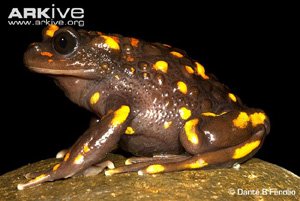
Source: http://www.arkive.org.
Fig. 27. Telmatobufo venustus.
24. Guiana Highland Tree Frog kind
Ceuthomantidae
1 genus (Ceuthomantis)
4 species—SVL = 2.5 cm (1”)
This genus is found in the Guiana highlands of northeastern South America. Characters include T-shaped terminal phalanges, adductor musculature of the “S” type, paired lipid-containing protrusions of unknown function in the post-temporal and sacral regions that look like glands but are not, a very poorly ossified neurocranium, an unusually large neopalatine bone, notched digital discs on fingers and toes, no vomerine teeth (found on roof of mouth), and presumed direct development of terrestrial eggs (Amphibiaweb 2013). No hybridization data was found.
25.Barking Rain Frog kind
Craugastoridae
2 genera (Haddadus) 2 species (Craugastor)
113 species—SVL = 4 cm (1.5”)

Photograph: Diogo B. Provete. Source: http://elo.org.
Fig. 28. Haddadus binotatus.
The mostly terrestrial species in this family are direct developing and found from the south western United States, through Central America, and into South America. Characters shared include cartilaginous sternum, vertebral shield absent, eight presacral vertebrae, presacrals I and II not fused, omosternum present, blunt, pedicellate teeth, frontoparietal fontanelle usually absent, cranial elements not co-ossified with overlying skin, T-shaped terminal phalanges, three phalanges in Finger IV, and a fully developed and free first toe (Amphibiaweb 2013). There is little known about Haddadus, and much unknown about most species in Craugastor, a few of which may be extinct.
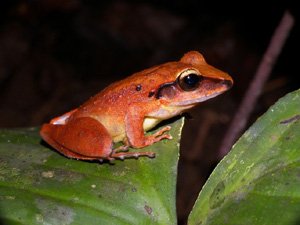
Source: http://en.wikipedia.org/wiki.
Fig. 29. Craugastor longirostris.
26. Ghost Frog kind
Heleophrynidae
2 genera (Heleophryne/Hadromophryne)
6 species—SVL = 5.5 cm (2.1”)
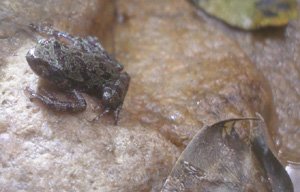
Source: http://en.wikipedia.org/wiki.
Fig. 30. Heleophryne orientalis.
The species in this family are quick moving frogs living along streams at high elevation in southern Africa (Amphibiaweb 2013). Shared characters include adults having large eyes with vertical pupils, triangular toe discs, slow tadpole development due to cold climate, absence of larval jaw sheaths, presence of many rows of denticles, males becoming more aquatic and secreting extra mucous during breeding season, similar skeletal structures as other neobatrachians, and inguinal amplexus (Amphibiaweb 2013; Vitt and Caldwell 2009, p 445).

Photograph: Luke Verburgt. Source: http://calphotos.berkeley.edu.
Fig. 31. Hadromophryne natalensis.
27. Shovel-Nose Frog kind
Hemisotidae
1 genus (Hemisus)
9 species—SVL = 6 cm (2.3”)

Fig. 32. Mottled shovel-nosed frog (Hemisus marmoratus). © Piotr Naskrecki / MINDEN PICTURES
The organisms in this taxon, from sub-Saharan Africa, have spherical bodies with hard, pointed snouts and strong legs for burrowing underground in their Savannah and sometimes scrub habitats (Amphibiaweb 2013; Vitt and Caldwell 2009, pp. 468–469). Reproduction is unique in that they lay eggs underground near the end of the dry season and when the nests flood, tadpoles either swim to ephemeral pools or hitch rides on parents who will transport them to pools where metamorphosis is completed (Amphibiaweb 2013). Other shared characters are similar with ghost frogs with the following differences: no sternum, eight presacral vertebrae with all but the last one being procoelous, fermisternal pectoral girdle, and blunt or pointed terminal phalanges.
28. Purple Frog kind
Nasikabatrachidae
1 genus (Nasikabatrachus)
1 species—SVL = 7 cm (2.7”)
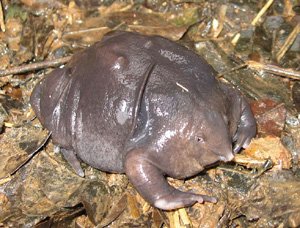
Source: http://en.wikipedia.org/wiki.
Fig. 33. Nasikabatrachus sahyadrensis.
This fossorial and explosive breeder is the only one of its kind and was discovered in India in recent years. During reproduction, amplexus happens with the much smaller male fastening on to the female spine. She transports the two of them to second order streams where he will push the eggs out of her, fertilize them in large numbers, and oviposit them in rock crevices (Amphibiaweb 2013). This occurs during the pre-monsoon season before aquatic predators have established themselves and their tadpoles have a stream morphology (thin and stream-lined) designed for fast flowing streams (Amphibiaweb 2013). Other characters include knob-like snout, rigid upper jaw, flap-like lower jaw which forms a grooved opening for tongue, no maxillary teeth, small eyes, single subgular vocal sac in males, no tympanum, little webbing in hands, round toes in feet with three-quarters webbing, horizontal pupils, strongly ossified skull, paired frontoparietals and palatines, eight procoelous presacral vertebrae, and pseudoarciferal pectoral girdle (Amphibiaweb 2013; Vitt and Caldwell 2009, p. 445).
29. Seychelles Frog kind—Sooglossidae
2 genera
Sechellophryne (2 species);
Sooglossus (2 species)—SVL = 2 cm (0.7”)
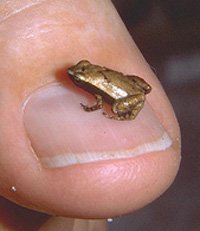
Photograph: Justin Gerlach. Source: http://www.iucnredlist.org/details/20380/0.
Fig. 34. Sechellophryne gardineri.
Endemic to the Seychelles they and Nasikabatrachidae are some of the only Neobatrachian members to perform inguinal amplexus, which is considered evolutionarily primitive (Amphibiaweb 2013). They share many Nasikabatrachidae characters which is why both families are considered closely related (Amphibiaweb 2013; Vitt and Caldwell 2009, p. 445). They become more active after rain and generally dwell in the leaf litter of the forest. Females of Sooglossus sechellensis deposit eggs in terrestrial nests where it is thought that the male guards them until they hatch, after which the non-feeding tadpoles crawl onto the backs of the male or female and complete their development (Amphibiaweb 2013; Vitt and Caldwell 2009, pp. 445–446). Reproductive behavior is similar with S. thomasseti except that direct development occurs and tiny froglets hatch from their terrestrial nest rather than tadpoles (Amphibiaweb 2013; Vitt and Caldwell 2009, p. 446). Females of Sechellophryne gardineri lay eggs under rocks and provide parental care while their young develop directly and hatch as froglets three to four weeks later (Vitt and Caldwell 2009, p. 446). S. pipilodryas breeding behavior is unknown but considered to be similar with S. gardineri.
Family Arthroleptidae
8 genera
147 species—SVL = 4 cm (1.5”)
These long limbed, pointed snout frogs are mostly small (2–3 cm [0.7–1.1”]), with the exception of Trichobatrachus robustus that gets as large as 13 cm (5.1”). Most reside in sub-Saharan Africa in habitats that range from forest to low or high elevation grasslands, with the exception of Leptopelis palmatus, which lives on the oceanic island of Principe (Amphibiaweb 2013; Vitt and Caldwell 2009, p. 470). Shared characters include paired palatines and frontoparietals, eight procoelous presacral vertebrae except for the last vertebra which has a biconcave surface, no dorsal ribs on post metamorphs, fermisternal pectoral girdle with distinct sternum, astragalus and calcaneum fused on ends, and blunt, pointed, or T-shaped tips on terminal phalanges (Vitt and Caldwell 2009, p. 470). Arthropeltis and possibly species in Leptopelis have direct development while every other known species has stream or pond morph tadpoles (Amphibiaweb 2013). Because of taxonomic controversy, the lack of information, and the highly diverse species ecology, life history, size, and morphology, I default kinds in this family to the genus.
30. Screeching Frog Kind
Genus Arthroleptis
49 species—SVL = 2 cm (0.7”)
31. Night Frog kind
Genus Astylosternus
12 species—SVL = 3 cm (1.1”)

Source: http://en.wikipedia.org/wiki/.
Fig. 35. Arthroleptis wahlbergii.

Photograph: Mary E. Gartshore. Source: http://www.arkive.org.
Fig. 36. Astylosternus laurenti.
32. Long-Fingered Frog kind
Genus Cardioglossa
16 species—SVL = 3 cm (1.1”)

Source: http://en.wikipedia.org/wiki.
Fig. 37. Cardioglossa leucomystax.
33. Egg Frog kind
Genus Leptodactylodon
15 species — SVL = 2 cm (0.7”)

Source: http://www.edgeofexistence.org.
Fig. 38. Leptodactylodon erythrogaster.
34. Big Eyed Frog kind
Genus Leptopelis
52 species—SVL = 5 cm (1.9”)
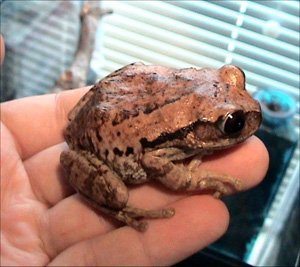
Source: http://en.m.wikipedia.org/wiki.
Fig. 39. Leptopelis vermiculatus.
35. Wrinkled Frog kind
Nyctibates
1 species—SVL = 3 cm (1.1”)

Source: http://eol.org.
Fig. 40. Nyctibates laevis.
36. Gabon Frog kind
Scotobleps
1 species—SVL = 3 cm (1.1”)

Photograph: Ignaclo De la Kiva. Source: http://www.fonozoo.com.
Fig. 41. Scotobleps gabonicus.
37. Hairy Frog kind
Trichobatrachus
1 species—SVL = 11 cm (4.3”)
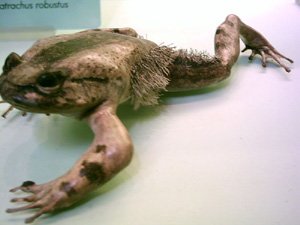
Source: http://en.wikipedia.org.
Fig. 42. Trichobatrachus robustus.
Mostly terrestrial, the hairy frog (Trichobatrachus robustus) may be the most well-known member of the family because breeding males have long epidermal extensions called dermal papillae that contain arteries and may increase respiratory effectiveness because of their small lungs and large body (Amphibiaweb 2013). Eggs are oviposited on rocks in streams and tadpoles are carnivorous and muscular (Amphibiaweb 2013).
Family Alsodidae
3 genera
30 species
Very little information is known for this family.
They used to be classified with Cycloramphidae. Therefore, I default the kinds to the genus level until further information on these species is illuminated in order to avoid underestimating the numbers on the Ark.
38. Spiny-Chest frog kind
Genus Alsodes
19 species—SVL = 4 cm (1.5”)

Source: http://en.wikipedia.org.
Fig. 43. Alsodes verrucosus.
Theses frogs are found in Chile and Argentina (Amphibiaweb 2013).
39. Miguel’s Toad kind
Eupsophus
10 species—SVL = 4 cm (1.5”)
This genus is found in Chile and Argentina.
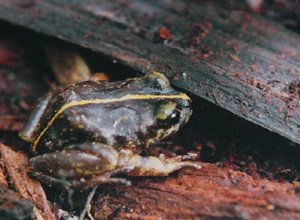
Source: http://en.wikipedia.org.
Fig. 44. Eupsophus emiliopugini.
40. Medusa Lake Frog kind
Limnomedusa
1 species—SVL = 4 cm (1.5”)
This genus is found in Argentina, Uruguay, Brazil, and possibly Paraguay.
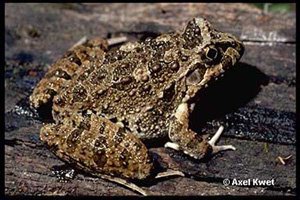
Source: http://en.wikipedia.org.
Fig. 45. Limnomedusa macroglossa.
Family Batrachylidae
4 genera
15 species
So little information is known on this family, I default the kind to the genus in order to avoid underestimating the numbers.
41. Patagonia Frog kind
Atelognathus
8 species—SVL = 4 cm (1.5”)

Photograph: Richard Sage. Source: http://www.arkive.org.
Fig. 46. Atelognathus nitoi.
42. Captain Fitzroy Frog kind
Batrachyla
5 species—3 cm (1.1”)
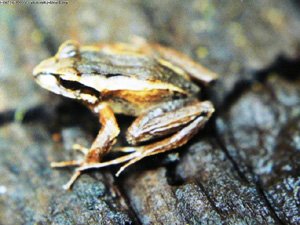
Source: http://en.wikipedia.org.
Fig. 47. Batrachyla teniata.
43. Magellanic Tundra Frog kind
Chaltenobatrachus
1 species—SVL = 4 cm (1.5”) (Basso et al. 2011)
44. Emerald Forest Frog kind
Hylorina
1 species—SVL = 5.5 cm (2.1”)
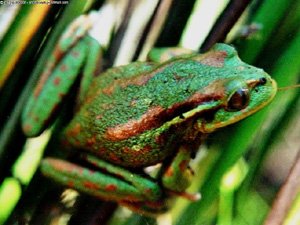
Source: http://en.wikipedia.org.
Fig. 48. Hylorina sylvatica.
45. Rain Frog kind
Family Brevicipitidae
5 genera (Balebreviceps, Breviceps, Callulina, Probreviceps, Spelaeophryne)
34 species—SVL = 4 cm (1.5”)

Photograph: M. J. Langen. Source: http://www.arkive.org.
Fig. 49. Balebreviceps hillmani.
Located in the eastern and southern regions of Africa, this family used to be classified as Microhylidae. However, strong molecular data, life history, and morphology argue for their monophyly (Amphibiaweb 2013). Shared characters include adhesive secretions allowing males and females to “stick” together during mating because short legs prevent any type of grasping during amplexus, spherical eggs deposited in underground cavities, direct developing embryos, spherical body shape with barely distinguishable head, robust limbs, no ethmoids (bone separating nasal cavity from brain), toothless maxillaries, and a diplasiocoelous vertebral column in which the eighth presacral vertebra is biconcave and the sacral vertebra is posteriorly biconvex (Amphibiaweb 2013; Vitt and Caldwell 2009, p. 468).
Family Bufonidae
50 genera
585 species—overall SVL = 9 cm (3.5”)
This family is endemically distributed worldwide except Australia. Bufonidae is also highly diverse and complex. For example, depending on the species, eggs can produce aquatic indirect developers or terrestrial direct developers. Moreover, at least two genera, Nectophrynoides (two species) and the monotypic Nimbaphrynoides are the only known ovoviviparous anurans that give birth to live young (Amphibiaweb 2013; Vitt and Caldwell 2009, p. 460). Shared characters include an organ found only in bufonids called the Bidder’s organ and located in male tadpoles in front of the kidney the function of which is still a mystery, no teeth in upper or lower jaws, depressor mandibulae muscle originating solely from the squamosal, inguinal fat bodies, and a highly ossified skull often with the skin ossified to the skull (Amphibiaweb 2013). Many, but not all, have moderate to highly toxic skin glands, larger glands in the dorsal neck area called parotoid glands, warty, sometimes spiny skin, perform axillary amplexus, and lay string-like egg masses in water. Unless otherwise stated, each kind below undergoes indirect development. Because of their complexity, diversity, and the lack of information on many genera, I default the kind to genus so numbers are not underestimated.
46. Dwarf Toad kind—Adenomus
3 species—SVL = 2 cm (0.7”)
47. Ethiopian Toad kind—Altiphrynoides
2 species—SVL = 3 cm (1.1”)
48. Amazon Toad kind—Amazophrynella
3 species—SVL = 2 cm (0.7”)
49. Togo Toad kind—Amietophrynus
40 species—SVL = 8 cm (3.1”)
50. Common/American Toad kind
Anaxyrus—22 species
Bufo—25 species—SVL = 8 cm (3.1”)
Anaxyrus (North American toads) and Bufo (Eurasian toads) used to be classified together in the genus Bufo until recently. Jensen et al. (2008) has reported interspecific hybridization in Anaxyrus. Artificial interspecific hybridization, producing fertile offspring, has been reported for the Japanese species B. japonica and B. torrenticola, but interspecific isolation seems to hold where they are sympatric in the wild (Amphibiaweb 2013). Because of similar morphology and behavior I combine both genera into the American/Common toad kind.

Source: http://en.wikipedia.org.
Fig. 50. Bufo americanus.

Source: http://en.wikipedia.org.
Fig. 51. Bufo bufo.
51. Andes Mountain Toad kind
Andinophryne
3 species—SVL = 3 cm (1.1”)
This is a rare and little known genus.
52. Stream Toad kind
Ansonia
26 species—SVL = 2.5 cm (0.9”)
This is a stream spawning south-east Asian toad with tadpoles having stream or torrent morphology.
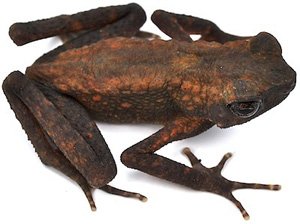
Source: http://frogsofborneo.org.
Fig. 52. Ansonia leptopus.
53. Harlequin Toad kind
Atelopus
97 species—SVL = 5 cm (1.9”)

Source: http://en.wikipedia.org.
Fig. 53. Atelopus certus.
These species tend to be brightly colored, small, and diurnal. These frogs are from Central and South America.
54. Morocco Toad kind
Barbarophryne
1 species—SVL = 4 cm (1.5”)
55. Mawblang Toad kind
Bufoides
1 species—SVL = unknown
56. Green Toad kind
Bufotes
16 species—SVL = 7 cm (2.7”)
57. Cape Toad kind
Capensibufo
2 species—SVL = 5 cm (1.9”)
58. Tanzanian Toad kind
Churamiti
1 species—SVL = unknown
59. Forest Toad kind
Dendrophryniscus
10 species—SVL = unknown
60. 4-Digit Toad kind
Didynamipus
1 species—SVL = unknown
D. sjostedti reproduction is suspected to be ovoviviparous (Amphibiaweb 2013).
61. Bony Skull Toad kind
Duttaphrynus
30 species—SVL = 6 cm (2.3”)

Source: http://en.wikipedia.org.
Fig. 54. Dendrophryniscus berthalutzae.

Source: http://en.wikipedia.org.
Fig. 55. Didynamipus sjosted.

Source: http://en.wikipedia.org.
Fig. 56. Bufo melanostictus.
62. Natterjack Toad kind
Epidalea
1 species—SVL = 6 cm (2.3”)
This is the only endemic toad of Ireland (Amphibiaweb 2013).
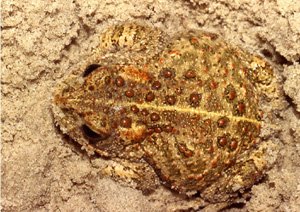
Source: http://en.wikipedia.org.
Fig. 57. Bufo calamita.
63. Frost’s Toad kind
Frostius
2 species—SVL = 3 cm (1.1”)
These toads have a symbiosis with bromeliad plants in which females lay their eggs and tadpoles develop (Amphibiaweb 2013).
64. Ornate Toad kind
Ghatophryne
2 species—SVL = 2 cm (0.7”)

Source: http://en.wikipedia.org.
Fig. 58. Ghatophryne ornata.
65. Gulf Coast Toad kind
Incilius
40 species—SVL = 8 cm (3.1”)
66. Philippine Toad kind
Ingerophrynus
12 species—SVL = 4 cm (1.5”)

Source: http://en.wikipedia.org.
Fig. 59. Bufo biporcatus.
67. Parkers Tree Toad kind
Laurentophryne
1 species—SVL = unknown
68. Indo-Javan Tree Toad kind
Leptophryne
2 species—SVL = 3 cm (1.1”)
69. South American Red Bellied Toad kind
Melanophryniscus
27 species—2.5 cm (0.9”)

Source: http://en.wikipedia.org.
Fig. 60. Melanophryniscus atroluteus.
Species in this family are brightly colored and secrete toxins from their skin while exhibiting the “unken reflex” defensive behavior (Amphibiaweb 2013).
70. Snouted Toad kind
Mertensophryne
14 species—SVL = 4 cm (1.5”)
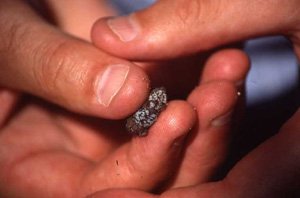
Source: http://en.wikipedia.org.
Fig. 61. Mertensophryne micranotis.
71. Rough Toad kind
Metaphryniscus
1 species—SVL = unknown
This species is a direct developer and may internally fertilize (Amphibiaweb 2013).
72. Malaga Toad kind
Nannophryne
4 species—SVL = unknown
73. African Tree Toad kind
Nectophryne
2 species—SVL = unknown
Species in this family nest in tree cavities containing water, tadpoles develop there, and parental care is exhibited (Amphibiaweb 2013).
74. Spray Toad kind
Nectophrynoides
13 species—SVL = 2.5 cm (0.9”)
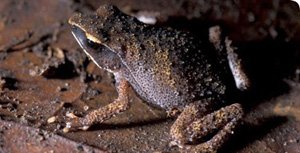
Source: http://www.nhm.ac.uk.
Fig. 62. Nectophrynoides wendyae.
Species in this group, along with Nimbaphrynoides (and possibly others), are the only known anurans to have both internal fertilization and give live birth (ovoviviparous) (Amphibiaweb 2013). Some feign death (N. asperginis) when disturbed, and have nostril covers that are designed for living in waterfall spray zones. Some males (N. tornieri) do pushups that may be visual displays for competing males or to increase sound transmission (Amphibiaweb 2013).
75. Nimba Toad kind
Nimbaphrynoides
1 species—SVL = 2.5 cm (0.9”)
Species in this group, along with Nectophrynoides (and possibly others), are the only known anurans to have both internal fertilization and give live birth (ovoviviparous) (Amphibiaweb 2013). The young are nourished by secretions of the female’s oviductal epithelium and have special structures around their mouths that probably help them ingest this special polysaccharide food source.
76. Bush Toad kind
Oreophrynella
9 species—SVL = 2 cm (0.7”)

Source: http://en.wikipedia.org.
Fig. 63. Oreophrynella quelchii.
One species known as the pebble toad (O. nigra) has a fascinating defense tactic that is also observed in the Mount Lyell lungless salamander (Hydromantes platycephalus) when a predator approaches. When they sense danger they curl into a ball and roll away (Amphibiaweb 2013).
77. Plump Toad kind
Osornophryne
11 species—SVL = 3 cm (1.1”)
Species in this family are direct developers and fossorial (Amphibiaweb 2013).
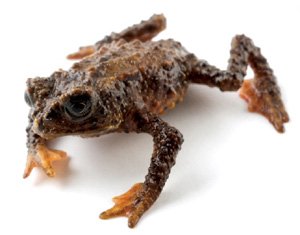
Source: http://en.wikipedia.org.
Fig. 64. Osornophryne simpsoni.
78. Chinese Toad kind
Parapelophryne
1 species—SVL—unknown
79. Asian Tree Toad kind
Pedostibes
5 species—SVL = 2 cm (0.7”)

Source: http://en.wikipedia.org.
Fig. 65. Pedostibes tuberculosus.
80. Flathead Toad kind
Pelophryne
12 species—SVL = 2 cm (0.7”)
Tadpoles of these species are endotrophic, meaning that they gain nutrition from an internal egg yolk rather than from the environment (Amphibiaweb 2013).
81. Crested Toad kind
Peltophryne
12 species—SVL = 10 cm (3.9”)
82. Giant Asian Toad kind
Phrynoidis
2 species—SVL = 12 cm (4.7”)

Source: http://frogsofborneo.org.
Fig. 66. Phrynoidis aspera.
83. Namibian Toad kind
Poyntonophrynus
10 species—SVL = unknown
84. False Toad kind
Pseudobufo
1 species—SVL = unknown?
85. Spotted Toad kind
Rhaebo
10 species—SVL = 11 cm (4.3”)
86. Marine Toad kind
Rhinella
86 species—SVL = 12 cm (4.7”)

Source: http://en.wikipedia.org.
Fig. 67. Bufo marinus.
In Australia, an exotic marine bufonid named the cane toad (Rhinella marinus) was introduced in the 1930s to eat beetle pests that were destroying the sugar cane. Ever since, it has been wreaking havoc on the local animal populations because it is highly toxic, in both its adult and larval stages, and has both a large size and appetite (Amphibiaweb 2013).
87. Sabah Toad kind
Sabahphrynus
1 species—SVL = 4 cm (1.5”)
88. Red Toad kind
Schismaderma
1 species—SVL = 8.5 cm (3.3”)
89. Mongolian Toad kind
Strauchbufo
1 species—SVL = 7 cm (2.7”)
90. Peruvian Toad kind
Truebella
2 species—SVL = 2 cm (0.7”)
91. Amatola Toad kind
Vandijkophrynus
5 species—SVL = 4 cm (1.5”)
92. Small Tongue Toad kind
Werneria
6 species—SVL = 3 cm (1.1”)
93. Wolterstorff Toad kind
Wolterstorffina
3 speciesvSVL = 3 cm (1.1”)
94. Amboli Toad kind
Xanthophryne
2 species—SVL = 3 cm (1.1”)
95. Glass Frog kind
Family Centrolenidae—12 genera
153 species—overall SVL = 5 cm (1.9”)
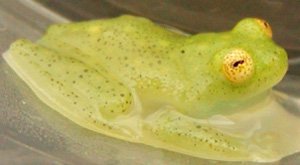
Source: http://en.wikipedia.org.
Fig. 68. Hruedai dorso.
Their family name refers to the common character of having a transparent venter, where many internal organs can be seen (Amphibiaweb 2013; Vitt and Caldwell 2009, pp. 453–454). Endemic to Central and South America, other common traits include green dorsal skin, green bones as a result of green bile salts, a unique skin pigment that reflects the same infrared radiation plants do, astragalus and calcaneum completely fused (as in Pelodytidae), dilated medial process on third metacarpal, T-shaped terminal phalanges, eight presacral vertebrae, no ribs, arciferal pectoral girdle, and palatines (Amphibiaweb 2013).
Typically Centrolenids are nocturnal forest frogs found in diverse elevational habitats that deposit eggs on upper leaf (or rock) surfaces over streams and the males of some species, guard them until they hatch (Amphibiaweb 2013). When the eggs hatch, the tadpoles drop into the water below, become fossorial, and complete their devolpment in the substrate (Vitt and Caldwell 2009, p. 354).
Family Ceratobatrachidae
5 genera
86 species
This family is in great flux and has been separated out from Ranidae. One common character is that they have a fermisternal pectoral girdle. Differences are that body morphology can range from tree-like forms to toad-like forms across this taxon. Because there is so much unknown and they are in great taxonomic flux, I will default the kind to genus.
96. Papua New Guiana Frog kind
Batrachylodes
8 species—SVL = 3 cm (1.1”)
97. Eyelash Frog kind
Ceratobatrachus
1 species—SVL = 3 cm (1.1”)
This monotypic frog has fangs called odontoids on its lower jaw that are probably used for subduing prey, including their own species, via ambush predation. It is direct developing (Vitt and Caldwell 2009, p. 473).
98. Solomon Islands Frog kind
Discodeles
5 species—SVL = 3 cm (1.1”)
Species in this family lay their eggs on the ground and are direct developers (Amphibiaweb 2013).
99. Palm Frog kind
Palmatorappia
1 species—SVL = 3 cm (1.1”)
100. Forest-Cave Frog kind
Platymantis
71 species—SVL = 5 cm (1.9”)

Source: http://en.wikipedia.org.
Fig. 69. Platymantis vitiensis.
Some species in this family lay eggs in leaf axils of trees or epiphytic plants and development is direct, while others, such as Platymantis spelaeus are found in caves (Amphibiaweb 2013).
Family Ceratophryidae
3 genera
12 species
This South American family shares the following characters and behavior: paired palatines and frontoparietals, trigeminal and facial nerves fusing to form a prootic ganglion, eight presacral, procoelous vertebrae, cartilaginous sternum, and axillary amplexus (Vitt and Caldwell 2009, p. 455).
101. Pacman Frog kind
2 genera—9 Species
Ceratophrys—8 species
Chacophrys—1 species—SVL = 11 cm (4.3”)

Source: http://en.wikipedia.org.
Fig. 70. Ceratophrys ornata.
Shared unusual characters include a strong, hyperossified skull with heavy calcification and ornamentation, pronounced interocular crests, and long tubercles on the eyelids. Their mouths may be 1.5 times wider than they are long, and they are voracious predators (Amphibiaweb 2013). Because of their common morphology and behavior I place both genera as a biblical kind.
102. Budgett’s Frog kind
Lepidobatrachus
3 species—SVL = 8 cm (3.1”)
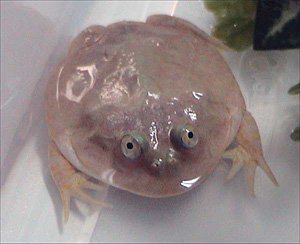
Source: http://en.wikipedia.org.
Fig. 71. Lepidobatrachus laevis.
Characters include large teeth on the upper jaw, two large fangs on the lower jaw, rhomboid pupils, short forelimbs and hind limbs, unwebbed digits of the forelimbs, fully webbed hind limbs with a large, and a spade-like, black tubercle on the metatarsal (Amphibiaweb 2013). I have made this genus a separate kind from the rest of the family because of its unique behavior and biology. Species in this genus live in arid places of South America. It is unique in the way it burrows and aestivates during the dry season. It has been designed to withstand the stress by shedding layers of skin that remain connected to the body. As these layers build, they form a cocoon around the frog which protects it from dehydration (Amphibiaweb 2013). When the rainy season arrives, they leave their burrows and find ephemeral pools for breeding and foraging. When their breeding season begins, 1400 eggs may be produced and larval development is rapid (Amphibiaweb 2013). They are both carnivores and cannibals and, though this post-Fall feeding behavior is rare in anuran larvae, what makes them even more unique are their jaws. They have wide gaping mouths, just like the adults, that allow them to ingest their prey whole. This unique feeding behavior is called megalophagy (Amphibiaweb 2013).
103. Goliath Frog kind

Source: http://en.wikipedia.org.
Fig. 72. Conraua goliath.
Conrauidae
1 genus Conraua
6 species—maximum SVL = 32 cm (12.5”)
As a new family, taxonomic data is still in flux. C. goliath is reported to be the largest anuran on earth measuring 32 cm (12.5”) and weighing over 3 kg (6.6 lb) (Amphibiaweb 2013). In general they are creatures of fast flowing, highly oxygenated rivers and cascades of Equatorial Guinea. Average SVLs could not be obtained for the other five species.
104. Cascade Frog kind
Family Cycloramphidae
2 genera
Cycloramphus—28 species Thoropa—6 species—SVL = 4 cm (1.5”)
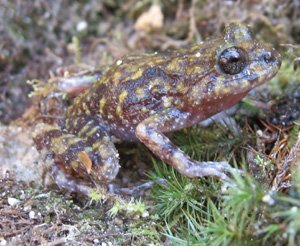
Source: http://en.wikipedia.org.
Fig. 73. Cycloramphus eleutherodactylus.
This family is found in South America, often on islands and waterfall splash zones, and its taxonomy is still in great flux. Many have unique reproductive modes and lay terrestrial eggs in rock crevices (Amphibiaweb 2013). Because of their unique behavior and locale, I group them together as a kind.
105. Dart Poison Frog kind
Family Dendrobatidae
18 genera
293 species—SVL = 3 cm (1.1”)

Source: http://en.wikipedia.org.
Fig. 74. Dendrobates azureus.
This family has been recently revised and continues to be in taxonomic flux. Many are brightly colored and all reside in the neotropics (Amphibiaweb 2013). Their name comes from highly toxic lipophilic alkaloids (batrachotoxins and homobatrachoxins) in the skin of many species (e.g. Phyllobates terribilis, Phyllobates aurotaenia, and Phyllobates bicolor) that is derived from eating ants, beetles, and possibly other invertebrates (Amphibiaweb 2013; Vitt and Caldwell 2009, pp. 462–464). P. terribilis is the most toxic anuran on the planet with toxin concentrations 20 times greater than other dendrobatids (Amphibiaweb 2013). Skin toxins of these frogs were used to coat the tips of arrows for blowgun hunting in Columbia. Other species are non-toxic and cryptic. Shared characters include similar skeletal morphology to other neobatrachians, short, strong hind limbs, climbing and jumping agility, divided scutes (thick pads of skin) on the dorsal surface of their digits, diurnal behavior, oviposition of eggs on land, and unique cephalic amplexus (Amphibiaweb 2013). When the eggs hatch in many species, tadpoles are transported to various water bodies on the backs of parents (males or females depending on species) and parental care may continue until tadpoles fully develop (Amphibiaweb 2013; Vitt and Caldwell 2009, p. 463). In several species, the parent will visit tadpoles and feed them unfertilized eggs (Amphibiaweb 2013). Other tadpoles are oophagic in captivity and some interspecific hybridization has been inferred within some captive care breeding sites. There is still great uncertainty with their taxonomic status, but because of very similar morphology, behavior, locality, and the belief that the differences shared are well within the current genetic ability to respond to environmental variability, I default the kind to the family.
Family Dicroglossidae
13 genera
186 species
Species range from central and sub-Saharan Africa to Eurasia and have similar morphology as other neobatrachians. Because this family is highly variable, has limited taxonomic information, and to avoid underestimating numbers, I place the kind at the genus.
106. Sikkimese Frog kind
Ombrana
1 species—SVL = 3 cm (1.1”)
107. Hazara Torrent Frog kind
Allopaa
2 species—SVL = 10 cm (3.9”)—aquatic
108. Karaz Frog kind
Chrysopaa
1 species—SVL = 10 cm (3.9”)
109. Indian Five-Fingered Frog kind
Euphlyctis
6 species—SVL = 11 cm (4.3”)—aquatic
110. Crab-Eating Frog kind
Fejervarya
42 species—SVL = 4.5 cm (1.7”)
F. cancrivora is the only living amphibian that can constantly live in salt water (Amphibiaweb 2013). It is quite possible that this species is a separate kind that could have survived outside the Ark because it can adapt from freshwater to brackish water in hours (Amphibiaweb 2013). It survives these differing osmotic environments by regulating high levels of urea concentrations in their blood plasma (Dicker and Elliott 1970; Vitt and Caldwell 2009, p. 180). The frog has three types of skin glands: mucous glands, mixed glands, and vacuolated glands; these may also be designed to increase salinity tolerance (Seki, Kikuyama, and Yanaihara 1995).
111. Indus Valley Bullfrog kind
Hoplobatrachus
5 species—SVL = 10 cm (3.9”)
112. Forked Tongue Frog kind
Limnonectes
57 species—SVL = 8 cm (3.1”)
Species in this genus are also known as fanged frogs.
113. Rock Frog kind
Nannophrys
4 species—SVL = 4 cm (1.5”)
114. Murree Hills Frog kind
Nanorana
27 species—SVL = 8 cm (3.1”)
115. Spiny Vented Frog kind
Quasipaa
10 species—SVL = 4 cm (1.5”)
116. Indian Burrowing Frog kind
Sphaerotheca
7 species—SVL = 4 cm (1.5”)
117. Papillae-Tongued Frog kind
Ingerana
13 species—SVL = 3 cm (1.1”)
118. Java Frog kind
Occidozyga
12 species—SVL = 3 cm (1.1”)
119. Coquí Frog kind
Family Eleutherodactylidae
4 genera
206 species—SVL = 5 cm (1.9”)

Source: http://en.wikipedia.org.
Fig. 75. Eleutherodactylus jasperi.
These direct-developing frogs range from Texas and Florida to the West Indies and south to the Amazon Basin. Miniaturization in anurans is found in this family as well as Brachycephalidae, Leptodactylidae, Microhylidae, and Sooglossidae (Amphibiaweb 2013). Eleutherodactylus iberia is one of the smallest frogs in the world. The rare reproductive mode of ovoviviparity is also found in Eleutherodactylus jasperi, but this species has not been seen since 1981 and may be extinct (Amphibiaweb 2013). Shared characters are similar to other neobatrachians.
120. Marsupial Horned Frog kind Family Hemiphractidae
6 genera
101 species—SVL = 6 cm (2.3”)
This Central and South American anuran family is unique in that larvae directly develop on the backs of adult frogs (Amphibiaweb 2013). They are called marsupial frogs because five of the six genera (Flectonotus, Fritziana, Gastrotheca, Cryptobatrachus, and Stefania) carry the developing embryos in a dorsal pouch while Hemiphractus lacks it (Amphibiaweb 2013).
Family Hylidae
49 genera
930 species
One of the largest anuran families and plentiful in the New World, these species vary in their reproductive mode and size. The characters they share include similar skeletal structure as other frog taxa, axillary amplexus, and distinct adhesive toe discs for climbing. The three subfamilies recognized are Pelodryadinae—3 genera, 202 species from Australia and New Guinea; Phyllomedusinae—6 genera, 53 species—from Mexico through Central and South America; Hylinae—38 genera—675 species—from North, Central America, South America, Eurasia, and North Africa (Amphibiaweb 2013). Interspecific hybridization has been reported within Hylinae and Phyllomedusinae, but do not connect the subfamilies (Gray 2011; Jensen et al. 2009). Because of taxonomic uncertainty and similar morphology, I place the kind at the subfamily until relationships are clearer.
121. Australo-New Guinea Tree Frog kind
Subfamily Pelodryadinae—SVL = 5 cm (1.9”)
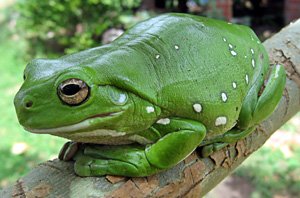
Source: http://en.wikipedia.org.
Fig. 76. Litoria caerulea.
This group contains mostly arboreal to terrestrial and a few semi-fossorial species (Vitt and Caldwell 2009, p. 452). Interesting examples include Cyclorana platycephala, also called the water holding frog because of their ability to store water in their bladder which Aborigines would squeeze out of them when they were thirsty (Amphibiaweb 2013). Litoria nasuta is called the rocket frog by Australian children because it can jump a meter or more in one bound (Vitt and Caldwell 2009, p. 452).
122.Arboreal Leaf Frog kind
Subfamily — Phyllomedusinae SVL = 6 cm (2.3”)
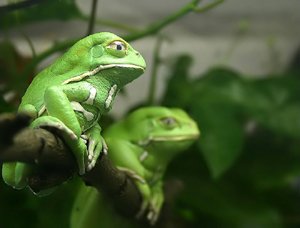
Source: http://en.wikipedia.org.
Fig. 77. Phyllomedusa sauvagii.
Pupils are vertical and many lay eggs on leaves, from which the hatched tadpoles drop into water (Amphibiaweb 2013; Vitt and Caldwell 2009, pp. 452–453). They are also known for secreting antibacterial and antifungal peptides from their skin (Amphibiaweb 2013). Some change skin color from day to night, and some can glide from tree to tree (Amphibiaweb 2013). Many Phyllomedusa species are more adapted for arid environments because they can decrease their water loss by excreting uric acid rather than urea. Further, most produce a lipid secretion they can wipe along their bodies to reduce water loss from their skin (Vitt and Caldwell 2009, p. 452). After laying eggs on a leaf overhanging water, red-eyed treefrog (Agalychnis callidryas) embryos can distinguish sound vibration patterns between snakes, wasps, and rain fall. If vibrations are being made by wasp or snake predators they may hatch quickly to avoid predation, but will remain in the egg if vibrations are being caused by rainfall (Amphibiaweb 2013).
123. Chorus Tree Frog kind
Subfamily Hylinae—SVL = 4 cm (1.5”)
A shared character in this taxon includes claw-shaped terminal phalanges (Amphibiaweb 2013). Unusual members in this group include the “paradoxical frog” (Pseudis paradoxa), where tadpoles are three to four times larger than the adult and the gladiator frogs (Hypsiboas sp.) that build sand nests adjacent to streams (Amphibiaweb 2013; Vitt and Caldwell 2009, p. 452).
124. Foot-Flagging Stream Frog kind Family Hylodidae
3 genera
42 species—SVL = 5 cm (1.9”)
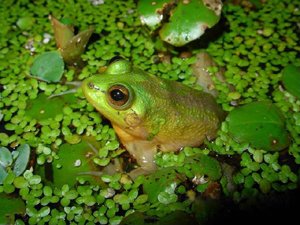
Source: http://en.wikipedia.org.
Fig. 78. Pseudis paradoxa.
A relatively new taxon of frogs from Brazil and Argentina, these tend to inhabit streams. Hylodes asper has an unusual way of communicating. Living in the loud environment of fast flowing streams and waterfalls, it would be hard to hear if it tried to vocalize, therefore it communicates by foot-flagging in which it slowly waves each rear foot, alternating them high above the body (Amphibiaweb 2013; Caldwell and Vitt 2009, p. 460).
125. Sedge and Bush Frog kind
Hyperoliidae
18 genera
223 species—SVL = 5 cm (1.9”)

Source: http://en.wikipedia.org.
Fig. 79. Heterixalus alboguttatus.
Located in sub-Saharan Africa this group is still in great taxonomic flux. Common characters found in most include pond tadpoles with large tailfins, bright colors, gular (throat) pads in males, competitive calling sites (Acanthixalus may communicate through pheromones), absence of nuptial pads, cartilaginous sternum, and vertical pupils (Amphibiaweb 2013).
126. White-Lipped Frog kind

Photograph: Alejandro Sanchez. Source: www.arkive.org.
Fig. 80. Eleutherodactylus amplinympha.
Leptodactylidae
6 genera
101 species—SVL = 10 cm (3.9”)
Many genera in this family are known for making foam nests from cloacal secretions for egg deposition (Vitt and Caldwell 2009, p. 455).
127. Madagascar Frog kind
Mantellidae
12 genera
205 species—SVL = 7 cm (2.7”)
Only found in Madagascar, some genera are similar to taxa in other families, suggesting they should be nested within other kinds. For example, Mantella traits such as body plan, aposematic coloration, and lipophilic skin alkaloids are very similar with Dentrobatidae (Amphibiaweb 2013). Genus Boophis appears similar to Hylinae. Habits differ depending on species and members may be arboreal, aquatic, or terrestrial (Amphibiaweb 2013). There is a diversity of life histories depending on species, but a unique male reproductive behavior is found in this family where during amplexus the male grasps the female’s head and releases sperm so that it flows down her back and on to the oviposited eggs (Amphibiaweb 2013).
128. Indian Water Frog kind
Micrixalidae
1 genus
11 species—SVL = 4 cm (1.5”)
129. Narrow Mouth Frog kind
Microhylidae
68 genera
526 species—SVL = 5 cm (1.9”)
Mostly fossorial, with some terrestrial and arboreal species, they are found throughout the world except Antarctica (Vitt and Caldwell 2009, p. 464). Common characters include stout hind legs, short snouts, globose bodies, cornified denticles absent in larvae, glottis fully exposed in the buccal floor in larvae, and larval nares not perforated (Amphibiaweb 2013). This family is in taxonomic flux.
130. Australo-Tasmanian Hip Breeding Frog kind
Myobatrachidae
21 genera
131 species—SVL = 7 cm (2.7”)
Found in Australia, Tasmania, and New Guinea they have a diversity of reproductive strategies. A unique breeding behavior in some involves eggs and tadpoles developing in 2 slit-like pouches on the hips (Amphibiaweb 2013). Rheobatrachus, which may be extinct, could turn off gastric production in the stomach so that their swallowed eggs could develop there without being digested (Amphibiaweb 2013). Morphotypes in this group are diverse, but similar to other anuran morphologies and many are endangered or extinct (Amphibiaweb 2013).
I have placed the following families as kinds because of similar morphology, similar biochemistry, and taxonomic uncertainties. It is possible that the kind consists of many of these lumped into larger taxa or split into smaller taxa.
131. Robust Frog kind
Nyctibatrachidae
3 genera
29 species—SVL = 5 cm (1.9”)

Source: http://en.wikipedia.org.
Fig. 81. Nyctibatrachus.
132. Smooth Horned Frog kind
Odontophrynidae
3 genera
41 species—SVL = 4 cm (1.5”)

Source: http://en.wikipedia.org.
Fig. 82. Odontophrynus americanus.
133. African Puddle Frog kind
Phrynobatrachidae
1 genus
86 species—SVL = 3 cm (1.1”)
134. Ridged Frog kind
Ptychadenidae
3 genera
51 species—SVL = 5 cm (1.9”)
135. African Bullfrog kind
Pyxicephalidae
13 genera
17 species—SVL = 9 cm (3.5”)
136. True Frog kind
Ranidae
14 genera
362 species—SVL = 12 cm (4.7”)

Source: http://en.wikipedia.org.
Fig. 83. Rana temporaria.
Interspecific hybridization has been reported in Ranidae including a type of reproduction called hybridogenesis (Beerli 1995). In European ranids, Rana lessonae and R. ridibunda produce a hybrid called R. esculenta. Female R. esculenta may mate with purebred males of R. lessonae or R. ridibunda and during the larval stage, the purebred male genome is lost in the gonads of R. esculenta and only females are produced.
137. Ghats Frog kind
Ranixalidae
1 genus
10 species—SVL = 4 cm (1.5”)
138. Asian Tree Frog kind
Rhacophoridae
19 genera
363 species—SVL = 5 cm (1.9”)
Evidence suggests that they are related to Ranidae but they are mostly arboreal having the enlarged toe disks as found in New World Hylids (Amphibiaweb 2013). Some also have a lot of webbing and can glide from tree to tree like members in Hylidae (Amphibiaweb 2013).
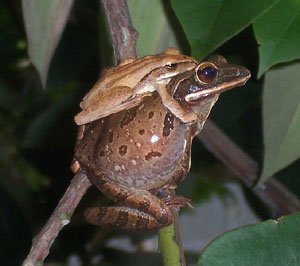
Source: http://en.wikipedia.org.
Fig. 84. Polyp leucom.
139. Mouth Brooding Frog kind
Rhinodermatidae
2 genera
3 species—SVL = 3 cm (1.1”)

Source: http://en.wikipedia.org.
Fig. 85. Rhinoderma darwinii.
Their family name comes from the proboscis looking structure on the top of their snouts (Amphibiaweb 2013). Taxonomists would include this family in Leptodactylidae but they do not because they lay eggs on land and tadpoles either develop in the vocal sacs of males (Rhinoderma darwinii) or are carried to water and released by males of Rhinoderma rufum (Amphibiaweb 2013).
140. Andean Highland Frog kind
Telmatobiidae
2 genera
61 species—SVL = 8 cm (3.1”)
Some species in Telmatobius are fully aquatic frogs.
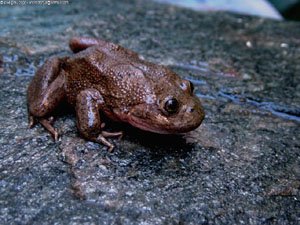
Source: http://en.wikipedia.org.
Fig. 86. Telmatobius.
Summary and Conclusions
Anurans are made up of an extraordinary number of species living in highly diverse habitats, and with highly diverse lifestyles, behaviors, and design features. The above descriptions were meant to provide a glimpse of the variety and taxonomic challenges inherent in the study of frogs. New molecular data is being collected every day, while new species are being identified every year. This is causing frog taxonomy to be in constant flux and highly tentative. Furthermore, seven species from the genera Crossodactylodes (3), Rupirana (1), and Zachaenus (3) have not been categorized to date. Therefore any attempt to determine the number of anuran kinds is a daunting task (Amphibiaweb 2013). With the above in mind, I tentatively place the number of extant anuran kinds on the Ark at 140. Whatever the number actually was, it is clear that frogs and toads represent the amazing diversity that is consistent with the Creator’s triune character and the creative wisdom required to build fascinating creatures with the ability to persist and thrive, in a fallen world.
Acknowledgments
I would like to thank Dr. Gordon Wilson for his insight and feedback on previous drafts.
References
AmphibiaWeb: Retrieved from http://amphibiaweb.org on June 20, 2013.
Basso, N. G., C. A. Úbeda, M. M. Bunge, and L. B. Martinazzo. 2011. A new genus of neobatrachian frog from southern Patagonian forests, Argentina and Chile. Zootaxa 3002: 31–44.
Beerli, P. 1995. Water frog hybrids. Retrieved from http://tolweb.org/notes/?note_id=578 on June 21, 2013.
Bergman, J. 2013. The problem of amphibian origins. Creation Research Quarterly 49, no. 3:218–229.
Biton, R., E. Geffen, M. Vences, O. Cohen, S. Bailon, R. Rabinovich, Y. Malca, T. Oron, R. Boistel, V. Brumfeld and S. Gafny. 2013. The rediscovered Hula painted frog is a living fossil. Nature Communications 4, Article number: 1959. Abstract retrieved from http://www.nature.com/ ncomms/2013/130604/ncomms2959/full/ncomms2959.html on June 10, 2013.
Blackburn, D. C. and D. B. Wake. 2011. Class Amphibia Gray, 1825. In Animal biodiversity: an outline of higher-level classification and survey of taxonomic richness, ed. Z.-Q. Zhang. Zootaxa 3148:38–54.
Bloom, S., C. Ledon-Rettig, C. Infante, A. Everly, J. Hanken, and N. Nascone-Yoder. 2013. Developmental origins of a novel gut morphology in frogs. Evolution and Development 13, no. 3:213–223.
Brophy, T. R. and P. A. Kramer. 2007. Preliminary results from a baraminological analysis of the moles salmanders (Caudata: Ambystomatidae). Occasional Papers of the BSG 10:10–24.
Cannatella, D. 2008a. Bombinatoridae. Bombinas and barbourulas. Retrieved from http://tolweb.org/Bombinatoridae/16971 on May 20, 2013.
Cannatella, D. 2008b. Ascaphus. Retrieved from http://tolweb.org/Ascaphus/16966 on May 22, 2013.
Cannatella, D. 2008c. Leiopelmatidae. Retrieved from http://tolweb.org/Leiopelma/16968 on May 22, 2013.
Cannatella, D. 2008d. Pelobatidae: Spadefoot toads. Retrieved from http://www.tolweb.org/Pelobatidae on May 22, 2013.
Dicker, S. E. and A. B. Elliott. 1970. Water uptake by the Crab-eating frog Rana cancrivora, as affected by osmotic gradients and by neurohypophysial hormones. Journal of Physiology 207, no.1:119–132.
Dubois, A. 2005. Amphibia Mundi. 1.1. An ergotaxonomy of recent amphibians. Alytes 23:1–24.
Duellman, W. E. and L. Trueb. 1986. Biology of amphibians. New York, New York: McGraw-Hill.
Duellman, W .E. (ed.). 1999. Patterns of distribution of amphibians: A Global Perspective. Baltimore, Maryland: Johns Hopkins University Press.
Frost, D. R. 1985. Amphibian species of the world: A taxonomic and geographical reference. Lawrence, Kansas: Allen Press and Association of Systematics Collections.
Frost, D. R., T. Grant, J. Faivovich, R. H. Bain, A. Haas, C. F. B. Haddad, R. A. De Sá et al. 2006. The amphibian tree of life. Bulletin American Museum of Natural History 297:1–370.
Gray, A. R. 2011. Notes on the hybridization of leaf frogs in genus Agalychnis (Anura, Hylidae, Phyllomedusinae). Retrieved from https://arxiv.org/ftp/arxiv/papers/1102/1102.4039.pdf on June 18, 2013.
Hennigan, T. 2013. An initial estimate toward identifying and numbering amphibian kinds within the orders caudata and gymnophiona. Answers Research Journal 6:17–34. Retrieved from http://www.answersingenesis.org/articles/arj/v6/n1/amphibian-kinds.
Heying, H. 2003. Pelodytidae. Animal Diversity Web. Retrieved from http://animaldiversity.ummz.umich.edu/accounts/Pelodytidae on May 23, 2013.
Jensen, J. B., C. D. Camp, W. Gibbons, and M. J. Elliot (eds). 2008. Amphibians and reptiles of Georgia. Athens, Georgia: University of Georgia Press.
Lightner, J. K., T. Hennigan, and G. Purdom. 2011. Determining the Ark kinds. Answers Research Journal 4: 195–201. Retrieved from http://www.answersingenesis.org/articles/arj/v4/n1/ark-kinds-flood-baraminology-cognitum.
Orton, G. L. 1953. The systematics of vertebrate larvae. Systematic Zoology 2, no. 2:63–75
Orton, G. L. 1957. The bearing of larval evolution on some problems in frog classification. Systematic Zoology 6, no. 2:79–86.
Pyron, R. A. and J. J. Wiens. 2011. A large-scale phylogeny of Amphibia with over 2800 species, and a revised classification of extant frogs, salamanders, and caecilians. Molecular Phylogenetics and Evolution 61:543–583.
Pough, F. H., R. M. Andrews, J. E. Cadle, J. E. Crump, A. H. Savitsky, and K. D. Wells, 2004. Herpetology, 3rd ed. Upper Saddle River, New Jersey: Pearson Prentice Hall.
Roelants, K. and F. Bossuyt. 2005. Archaeobatrachian paraphyly and pangaean diversification of crown-group frogs. Systematic Biology 54, no.1:111–126. Retrieved from http://sysbio.oxfordjournals.org/content/54/1/111.full on May 22, 2013.
Roelants, K., A. Haas, and F. Bossuyt. 2011. Anuran radiations and the evolution of tadpole morphospace. Proceedings of the National Academy of Sciences of the United States of America 108, no.21:8731–8736. Retrieved from http://www.pnas.org/content/108/21/8731.full on March 30, 2013.
Sanders, R. W. and K. P. Wise. 2003. The cognitum: A perception-dependent concept needed in baraminology. In Proceedings of the Fifth International Conference on Creationism, ed. R. L. Ivey, pp. 445–456. Pittsburgh, Pennsylvania: Creation Science Fellowship.
Seki, T., S. Kikuyama, and N. Yanaihara. 1995. Morphology of the skin glands of the crab-eating frog (Rana cancrivora). Zoological Science 12, no. 5:623–626.
Turner, K. J. 2009. The kind-ness of God: A theological reflection of mîn, “kind.” In CORE Issues in Creation no. 5, ed. T. C. Wood and P. A. Garner, pp. 31–64. Eugene, Oregon: Wipf and Stock.
Vitt, L. J. and J. P. Caldwell. 2009. Herpetology: An introductory biology of amphibians and reptiles, 3rd ed. Burlington, Massachusetts: Academic (Elsevier) Press.
Williams, P. J. 1997. What does min mean? CEN Tech J. 11, no. 3:344–352.
Wilson, G. 2010. Classic multidimensional scaling isn’t the sine qua non of baraminology. Retrieved from http://www.answersingenesis.org/articles/aid/v5/n1/ cmds-baraminology on August 10, 2013.
Wood, T. C. 2006a. The current status of baraminology. Creation Research Society Quarterly 43, no. 3:149–158.
Wood, T. C. 2006b. Statistical baraminology workbook. Unpublished workbook presented at workshop during the BSG conference June 13, 2007, Liberty University, Lynchburg, Virginia.
Wood, T. C. 2003. Impact Article #363 Mediated Design. Institute for Creation Research: El Cajon, California. Retrieved from http://www.icr.org/i/pdf/imp/imp-363.pdf on August 10, 2013.
Woodmorappe, J. 1996. Noah’s Ark: A feasibility study. Santee, California: Institute for Creation Research.
Yanchukov, A., S. Hofman, J. M. Szymura, S. V. Mezhzherin, S.Y. Morozov-Leonov, N. H. Barton, and B. Nürnberger. 2006. Hybridization of Bombina bombina and B. variegata (Anura, Discoglossidae) at a sharp ecotone in western Ukraine: Comparisons across transects and over time. International Journal of Organic Evolution 60, no. 3:583–600.









